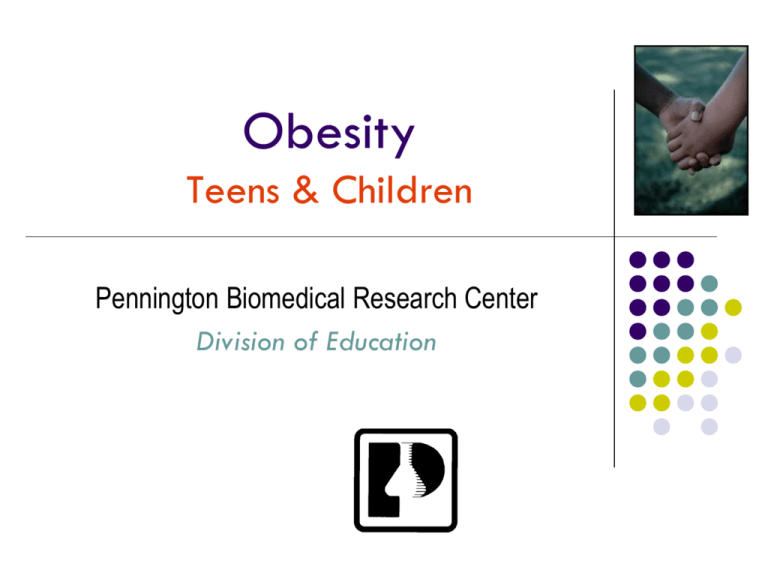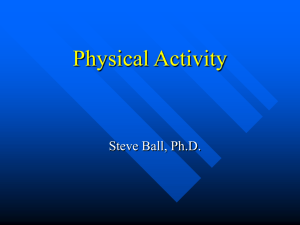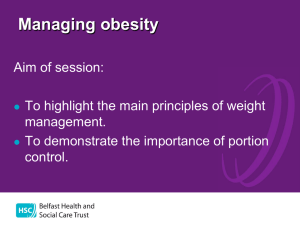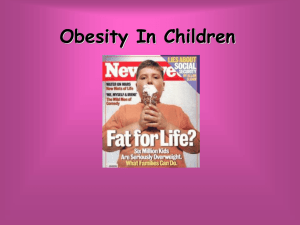Obesity Prevalence and Trends - Pennington Biomedical Research
advertisement

Obesity Teens & Children Pennington Biomedical Research Center Division of Education Introduction Overweight/obesity is not just a condition which plagues adults. In fact, many children and teens living in the United States are at a higher weight than they should be. It is important to adopt a healthy lifestyle in early years. Being overweight at any age increases your risk for health conditions both at present and later in life. Obesity in the U.S. Race/Ethnicity - Youth Among girls, the prevalence of overweight in Mexican-American and non-Hispanic blacks was higher than among non-Hispanic whites. Along boys, the prevalence of overweight was significantly higher among Mexican Americans than among either non-Hispanic blacks or whites. Obesity in the U.S. Age Adolescents were more likely to be overweight than were younger children. Older adults were more likely to be obese than were younger adults. The only exception was among adults 80 years of age and older, who were no different than adults 20-39 years of age. Obesity What are the Causes? Overweight and obesity are the result of an energy imbalance over a long period of time. While the whole picture is still unclear on how obesity develops, it is believed to involve the integration of social, behavioral, cultural, physiological, metabolic, and genetic factors. Behavior and environment appear to play a large role the development of obesity, and are often the focus for prevention and treatment actions. Energy Imbalance What is it? Weight Gain Energy balance is like a scale where both sides are of equal weight. An energy imbalance arises when the number of calories consumed is not equal to the number of calories used by the body. Weight gain usually involves the combination of consuming too many calories and not expending enough enough through physical activity, although weight gain could result from one or the other. Calories Consumed > Calories Used Weight Loss Calories Consumed < Calories Used No Weight Change Calories Consumed = Calories Used CDC Obesity Diet and Exercise Physical activity contributes to weight loss, especially when combined with a calorie reduction. Physical activity is important in preventing overweight and obesity and in maintaining weight that is lost. In addition to weight control, physical activity helps: Prevent heart disease Control cholesterol levels and diabetes To slow bone loss associated with advancing age Lower the risk of certain cancers Reduce anxiety and depression Body Mass Index Indicator of Weight Status Body mass index (BMI) is a mathematical ratio taking into account an individual’s weight, in kilograms, and height, in meters squared (kg/m2). This measure can be used for adults 20 years of age and older. With a BMI of: You are considered: Below 18.5 Underweight 18.5 - 24.9 Healthy Weight 25.0 - 29.9 Overweight 30 or higher Obese BMI determines an individuals weight category. You can find tables on the web that that are ready-made for you. http://www.nhlbisupport.com/bmi Body Mass Index It is important to remember that although BMI correlates with the amount of body fat a person has, it does not directly measure body fat. However, with the exception of highly trained athletes, BMI is a good predictor of chronic disease and mortality in individuals. Weight Classifications Children and Teens For children and teens, BMI ranges that are above a normal weight have different labels: at risk for overweight and overweight. In addition, BMI ranges for children and teens are defined in a way so that they can take into account: Normal differences in body fat between boys and girls Differences in body fat at various ages BMI for children and teens is often referred to as BMI-for-age. The following site allows for instant calculation of BMI in individuals aged 2 through 19: http://apps.nccd.cdc.gov/dnpabmi/Calculator.aspx Periods of Rapid Growth Childhood Teen age years Pregnancy Facts on Obesity Childhood Parental obesity more than doubles the risk of adult obesity among both obese and non-obese children who are under the age of 10. Weight gain and nutrition during pregnancy can determine the risk for obesity and other chronic diseases in later life. Among children older than 3, being overweight is a strong predictor of adult obesity. Childhood Antecedents to Obesity Parental weight Social class Race One-parent household Educational level Parental income Parental employment TV viewing # siblings Maternal age High caloric intake High dietary fat intake Physical activity level Obesity in the U.S. Children and Adolescents In 2003-04, approximately 12.5 million children and adolescents (17.1%) 2-19 years of age were considered overweight. A study of low income school children in Montreal, Canada found that: Nearly 42% were overweight, which was 2.6 times higher than expected. Johnson-Down et al 1997 Ten State Nutrition Survey Children and Teens Both girls and boys born to different parental combinations were followed, measuring and recording skin fold thickness each year from age three until seventeen. Based on the parent combination, the child was either at a higher or lower risk for being overweight later in life. The 5 different parental combinations: Lean and Lean Medium and Lean Medium and Medium Medium and Obese Obese and Obese 5 Parental Fatness Combinations Lean Lean L-L Medium Lean Medium Medium M-L M-M Obese Medium Obese Obese O-M O-O Skinfold Measurements This method is the most widely used body composition testing method for assessing percent body fat. The skinfold caliper is the instrument used to take the measurements of subcutaneous tissue at different sites. In this study, Tricep skinfold measurements of the participants were taken. Results of the Study Tricep Skinfold in Boys Parental Fatness Combinations 30 25 O-O O-M M-M M-L L-L 20 15 Mm 10 5 0 3 5 7 9 11 Age (Years) 13 15 17 Results of the Study Tricep Skinfold in Girls Parental Fatness Combinations 30 25 O-O O-M M-M M-L L-L 20 15 Mm 10 5 0 3 5 7 9 11 Age (years) 13 15 17 Ten State Nutrition Survey Results Based on Parental Combinations Comparing the children of obese with the children of lean, it was striking both how fat the children of the obese were, and how fast they gained their fatness. By age 17, the children of two obese parents were three times as fat as the children of two lean parents. Ten State Nutrition Survey In Summary… Factors such as ethnicity/race and age are important predictors of weight in the U.S. Children who are born of two overweight parents are more likely to become overweight adults, than are children who are born of two normal weight parents. However, being overweight is primarily the consequence of an imbalance between the number of calories consumed and the number of calories used by the body. Eating healthy and exercising regularly are important behaviors to adopt at an early age. Pennington Biomedical Research Center Division of Education Heli J. Roy, PhD, RD, Associate Professor Shanna Lundy, BS Beth Kalicki Division of Education Phillip Brantley, PhD, Director Pennington Biomedical Research Center Claude Bouchard, PhD, Executive Director Edited: October 2009 About Our Company The Pennington Biomedical Research Center is a world-renowned nutrition research center. Mission: To promote healthier lives through research and education in nutrition and preventive medicine. The Pennington Center has several research areas, including: Clinical Obesity Research Experimental Obesity Functional Foods Health and Performance Enhancement Nutrition and Chronic Diseases Nutrition and the Brain Dementia, Alzheimer’s and healthy aging Diet, exercise, weight loss and weight loss maintenance The research fostered in these areas can have a profound impact on healthy living and on the prevention of common chronic diseases, such as heart disease, cancer, diabetes, hypertension and osteoporosis. The Division of Education provides education and information to the scientific community and the public about research findings, training programs and research areas, and coordinates educational events for the public on various health issues. We invite people of all ages and backgrounds to participate in the exciting research studies being conducted at the Pennington Center in Baton Rouge, Louisiana. If you would like to take part, visit the clinical trials web page at www.pbrc.edu or call (225) 763-3000. Additional Resources: MyPyramid: Food Pyramid. Available at: http://www.mypyramid.gov References Centers for Disease Control and Prevention. Available at: http://www.cdc.gov Clinical guidelines on the identification, evaluation, and treatment of overweight and obesity in adults. Available at: http://www.nhlbi.nih.gov/guidelines/obesity/ob_exsum.pdf Johnson-Down L, O'Loughlin L, Koski KG, and Gray-Donald K. High Prevalence of Obesity in Low Income and Multiethnic Schoolchildren: A Diet and Physical Activity Assessment. The Journal of Nutrition Vol. 127 No. 12 December 1997, pp. 2310-2315.







